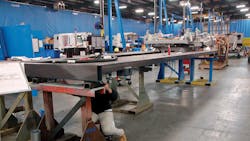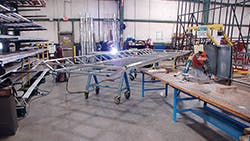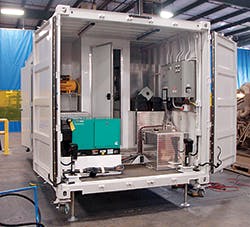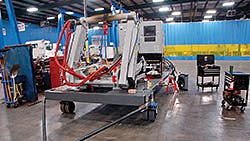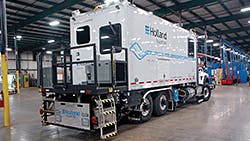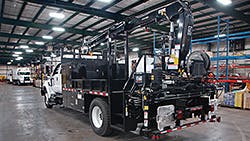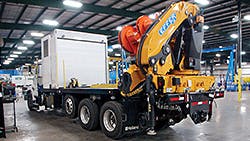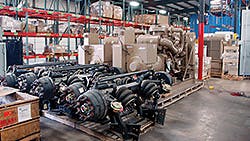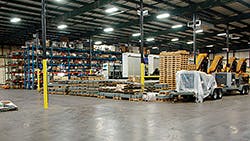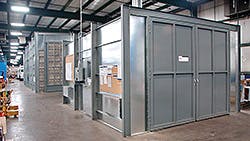Holland’s New plant builds low-volume work trucks with high-volume processes
Economies of scale by definition make it possible to lower unit costs. And by manufacturing the same product over and over again, product quality can rise, production rates can grow, and safety can improve.
But what if you build one product per month and a different type of product once a year?
That was the dilemma facing Holland LP until a couple of years ago. Even though the company served a narrow market—trucks and equipment for railroads—the product line within that market is diverse. Some of these niche products really were something the company only built on rare occasion. One order for one truck, maybe once a year.
Then another dilemma surfaced—demand for these myriad products began to grow. Not enough to match Ford or GM standards, but certainly enough to get management to ask itself how—and ultimately where—they would build a growing number of diverse trucks and equipment one small order at a time.
“At one point, we only had a 30,000-sq-ft plant,” says Tony Brummel, general manager of the Equipment Business Unit of Holland LP. “As the company grew, we added facilities wherever we could find them. We had one facility for polishers, one for hydraulics, and other locations for storage. Oh, we need high rail gear? Where is it? We had 11 different facilities. Things became very inefficient.”
Management concluded the company needed a minimum of 80,000-100,000 square feet if they were going to get everything in one building. Holland began a two-year process of evaluating options—to either build a new plant or convert an existing building into a place to produce low-volume vehicles with high levels of efficiency.
Teams of Holland personnel toured some of North America’s most innovative manufacturers to help design its new 185,000-sq-ft plant in University Park, Illinois, 15 minutes from corporate headquarters and about 40 miles south of downtown Chicago.
Holland also considered how a potential move would impact its employees. The company compiled a list of where its employees live and weighed that against each of the 20-30 potential sites that Holland considered along both sides of the Illinois-Indiana border.
The company selected an existing building in an industrial park relatively close to its previous location. The 185,000-sq-ft structure also was well above the minimum size that the company had in mind.
“The facility we chose is much larger than originally anticipated, but we want to have plenty of room to expand in the future,” Brummel says.
Doing their homework
When it comes to designing a new plant, most companies don’t start from scratch. Holland Equipment wanted to make sure they got this opportunity right the first time.
To help make that possible, Holland formed a team to see what other manufacturers have done, learn the techniques they are using, and come back with ideas they could implement in the building that formerly housed a distribution center.
“We gutted the offices and basically created for ourselves a clean slate,” says Bill McLaughlin, operations manager.
The company also had a clean slate in terms of plant layout and design. As part of the company’s two-year project, the team toured what Brummel describes as world class manufacturing facilities, including Duncan Aviation, Oshkosh Corporation, Pierce Manufacturing, and Harley Davidson.
“Most companies are proud of the plants they have designed, and they want to show them to others,” Brummel says. “We developed a list of 25-30 questions for each of the manufacturers and sent a team to tour these facilities. The teams took pictures and reported back what they found. When it comes to implementing the ideas, we chose the best of the best.”
Configurable manufacturing
The result of the research and implementation is what Brummel calls configurable manufacturing.
“We need to be able to change the production line easily,” he says. “Depending on the type and quantity of product that we are building, we can use an assembly line or cellular manufacturing. To do that, we place as much as we can on wheels and just move things around.”
The company has designed tables that take on the roles performed by other manufacturing tools: something that is partially a work fixture, a substitute for a bridge or jib crane, and a vehicle that moves components through the assembly process. The tables typically are built approximately 15-18 inches above the floor in an effort to reduce the need for workers to bend over.
One example is the company’s slewing crane—a crane that railroads use to position rail welding equipment. These heavy products are assembled on carts and rolled to the place where they are installed.
“The carts serve the purpose of cranes, forklifts, and conveyors,” Brummel says. “One of our goals is to eliminate forklifts. Studies have shown that forklift utilization in North American manufacturing average only 25% of the time. In addition, 50-60% of forklift travel is done without any load on the forks. The driver is moving empty to go pick up the next job. This is pure waste that we wanted to eliminate. Plus, we wanted to eliminate the safety issues associated with forklifts.”
Incentives for new ideas
Holland management recognizes that the real production experts are those who actually build the products. To tap employee expertise, Holland has developed an incentive program to encourage plant personnel to design their own workspace and other aspects of their work environment. The program also rewards them for improvements they make to work processes.
“What can we do to work smarter? If our standard process takes four steps, can they do it in three?” Brummel says. “It’s easy to identify inefficiencies when you are trained to look for them. Our incentive program gives people an extra reason to improve work processes. The same holds true for safety. We look for potential problems, and encourage employees to take courses that help them become safer and more productive at work.”
Truck body manufacturing
Holland began manufacturing its own truck bodies recently.
“We had been buying basic truck bodies and then modifying them to meet the needs of our customers,” Brummel says. “We had been buying from multiple manufacturers, but there are several advantages to building them ourselves. It provided the workforce with a new skill set, and it gave our company the ability to control our own destiny.
“We hired engineers who had experience designing truck bodies and learned that we can manufacture our own bodies at almost 50% of the price we had been paying. Plus, we reduced our tare weight by almost 1,000 pounds by using our own aluminum design instead of FRP.”
Truck body and trailer manufacturing has enabled Holland to expand its product offerings beyond its core railroad market. Other recent activities include building trailers for NASCAR, refurbishing mobile medical trailers, and potentially producing specialized trailers for Briggs & Stratton.
“With the new plant, we can take on different projects and be able to change over quickly,” Brummel says.
Keen on lean
In designing its new plant, Holland built in plenty of lean principles. This is to be expected since Bill McLaughline, the man responsible for its operation, holds green and black belts in lean manufacturing. The tours of other manufacturing plants further reinforced McLaughlin’s commitment to lean principles.
“Here’s what’s important: getting the right parts to the right place at the right time,” McLaughlin says. “Produce only what you need. Put it on the plant floor for that day’s production. Anything else is waste.”
One of the plants that really impressed him was the Harley Davidson facility
“Harley Davidson can deliver a custom motorcycle in about an hour,” McLaughlin says. “We don’t need to be that fast, but we need to be that flexible. Our products are all high-spec trucks and trailers. We can’t build 100 at a time—they are all going to be different. We need a system that gets the materials delivered, staged, and made into subassemblies. Plus, we need to get the final product assembled efficiently, with no waste. No one wants to pay for waste.
“We are big proponents of continuous improvement. The benchmark tours were helpful. Whether the companies we visited were new to lean or experienced, the thing we wanted to learn was how do you do it? Fortunately, we have a lot of ‘get it done’ type employees. The ideas we get come from the manufacturing and warehouse floor.”
The facility is designed to keep people working in cells.
“Everything comes to them,” McLaughlin says. “Body assembly, welding, hydraulic, and miscellaneous work cells. The result: the system is able to build every type of truck body that we produce.”
The cart system is something the Holland teams saw as they toured other manufacturing plants.
“If people are bending over all the time, it’s easy to get back strain, even if the load that they are required to lift isn’t all that heavy,” McLaughlin says. “Additionally, if you do a time study, you will appreciate how much difference a 15” cart makes.
Safety concerns
The company gave considerable thought to plant safety when designing the new plant.
“Safety is our Number 1 priority,” McLaughlin says. “We have had no injuries here in the past 17 months. That includes the time we were moving. The one-month period during which Holland sequentially moved its various departments into the new plant was a time of concern for management.
“Risk of injury goes up when people do things that they aren’t used to doing,” McLaughlin says. “We worked with the moving company to minimize the things employees had to do around their workspace to move into the new location. There are plenty of reasons to get people back to their normal routines as quickly as possible. Safety is one of them.”
The move was brief, but management also wanted the plant to be safe for the long term. The company focused on how things were to be lifted.
“The previous plant had full-length cranes,” McLaughlin says. “But with a cellular approach, no one has to wait for a crane. Instead, we developed ways to handle material. We have strategically placed cranes at the places where they are needed. None of these cranes have a capacity of more than five tons. We also use lift jacks where appropriate.”
Let’s communicate
A key component of making manufacturing efficient: communication. Holland has implemented graphic concepts that keep the plant floor informed but also relies on old-fashioned business meetings.
“Between six and eight people work in the engineering department—both mechanical and electrical engineers,” says Mark Eenigenburg, chief mechanical engineer. “We meet Mondays, Wednesdays, and Fridays to review each work station to be sure that each one has what it needs.”
The Holland engineers use SolidWorks, three-dimensional CAD software. They also use 3D printers to make low-volume functional parts, as well as to produce prototypes.
What they do
Holland is both a manufacturer and user of specialized rail trucks. One Holland LP business unit offers specialized contract services for the railroad industry. These include various types of rail welding, such as mobile, fixed plant, and containerized welding services.
Additionally, other business units offer track testing, rail measurement, track maintenance, construction services, and railcar components, railroad car cleaning, repair and sanitation services as well as transloading services for bulk commodities.
The company celebrated its 75th birthday in 2015. It was started in 1935 by Cyrus Holland to service railcar snubbers. ♦
For more information check out Holland.
About the Author
Bruce Sauer
Editor
Bruce Sauer has been writing about the truck trailer, truck body and truck equipment industries since joining Trailer/Body Builders as an associate editor in 1974. During his career at Trailer/Body Builders, he has served as the magazine's managing editor and executive editor before being named editor of the magazine in 1999. He holds a Bachelor of Journalism degree from the University of Texas at Austin.
